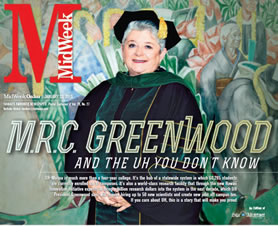M.R.C. Greenwood
UH-Manoa is much more than a four-year college. It’s the hub of a statewide system in which 60,295 students are currently enrolled on 10 campuses. It’s also a world-class research facility that through the new Hawaii Innovation Initiative expects to bring a billion research dollars into the system in the next decade, which UH President M.R.C. Greenwood says will require hiring up to 50 new scientists and create new jobs off campus, too. If you care about UH, this is a story that will make you proud
cover_2
What’s the first thing that comes to mind when you say “University of Hawaii”?
Whatever your response is – Warriors, traffic, tuition – replace it with another notion. Try “University of Hawaii, innovation center of the Pacific.”
Not sexy? Well, get used to it. Our economic destiny might depend on it.
Playing to a prevailing perception, let us suggest that there is a new sport at the UH. It’s called economic development, and we are all players.
It’s not as showy and spirited as football or those other inter-collegiate activities, but it scores high in statewide benefits, has a solid game plan and teaches us the value of keeping our eye on the ball.
Let’s face it. Recently we’ve been sidelined by distracting controversy at the Manoa campus. But when tactical errors occur, star players know they must learn from mistakes and quickly get back into the game.
With the rallying cry of carpe annum (seize the year), University of Hawaii System President M.R.C. Greenwood is back in the huddle to call the shots in the biggest game in town. That game is attracting and nurturing the greatest minds in our state to spur long-term prosperity.
As the top-ranking higher education administrator in the state, she is a leading economic adviser, planner and catalyst for work-force development.
If we haven’t viewed her in that context, we’ve possibly got the wrong playbook for the university’s place in the sun. It’s important to get on the right page because Greenwood is embarking on some big plays.
In our interview she heralds, “The sky is not the limit,” and takes us on a visionary journey to tomorrow while describing the university’s Hawaii Innovation Initiative (HI2) to generate $1 billion per year in research funds in the next decade. That’s 1,000,000,000 dollars (nine zeroes). Or, one gigabyte, for you data dudes.
If you play the numbers game, education/research is Hawaii’s fourth-largest industry, behind military spending, tourism and diversified agriculture. UH’s $1.4 billion annual operating budget ranks it fifth among Hawaii’s top companies.
Its revenue sources are federal grants and contracts (36 percent), state appropriations (33 percent), tuition and fees (31 percent).
Among the ways the school brings in outside dollars is through research.
The UH faculty currently generates more than $450 million per year in outside (extramural) funding for research projects. The goal is to double that by hiring 50 world-class researchers/scientists over the next five to eight years.
Overall, extramural funding has increased by 50 percent over the past 10 years. Princeton Review and The National Science Foundation rank UH-Manoa in the top 30 public universities for federal research funding in engineering and science.
World-class research is already taking place on UH’s 10 campuses on four islands. Studies range from mapping the ocean depths for marine research to developing satellites to study the earth from space.
UH could be the only university in the world with rocket-launch capability. (Hello, North Korea.) UH’s space flight laboratory is developing small satellites to be launched from Kauai’s Pacific Missile Range Facility this year.
Cutting-edge work also is being done in health sciences, renewable energy, new agriculture, cancer research, pharmacology and informatics (data processing and computation).
The proposed $40-million Culinary Institute of the Pacific at Kapiolani Community College, set to start construction this year, will take chef training to its highest level and benefit several sectors of Hawaii economy, including agriculture and tourism.
On Feb. 23, UH celebrates the grand opening of its $103-million Cancer Center in Kakaako, the only National Cancer Institute-designated facility in the Pacific.
“This is a significant event,” Greenwood says, noting that the building is being completed ahead of schedule and under budget.
In July, construction will be completed on a $41-million, 74,000-square-foot Information Technology Center next to Bilger Hall on the Manoa campus. Its 8,000-square-foot data center will have petabyte (quadrillion) storage capacity, expandable to exabyte (quintillion), for statewide research applications.
“We should be proud of what we have. If that makes me not humble, then I’m sorry,” says Greenwood.
But she makes no apology for the years of investment and effort that it took to bring UH to this juncture in global competitiveness. Since its founding in 1907, it has responded to the growing educational needs of an expanding world.
“Teaching is only one of the missions of the university,” the 69-year-old administrator says. “Research is not something the faculty does for themselves. When they do research or work-force development, they are creating jobs and opportunity in Hawaii.”
In launching three programs – Hawaii Graduation Initiative, Innovation and Technology Transfer, and Renovate to Innovate – UH is in step with the White House’s strategy for American innovation.







